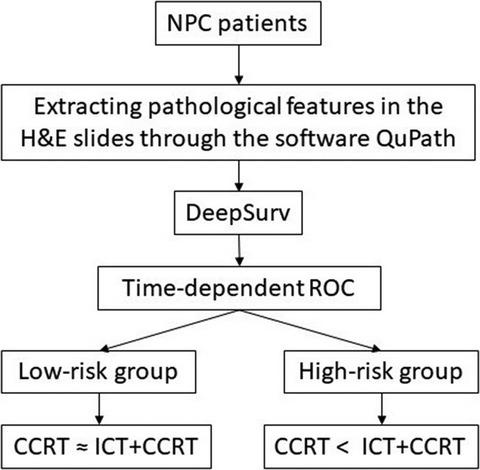当前位置:
X-MOL 学术
›
Cancer Med.
›
论文详情
Our official English website, www.x-mol.net, welcomes your
feedback! (Note: you will need to create a separate account there.)
Deep learning pathological microscopic features in endemic nasopharyngeal cancer: Prognostic value and protentional role for individual induction chemotherapy.
Cancer Medicine ( IF 2.9 ) Pub Date : 2019-12-20 , DOI: 10.1002/cam4.2802 Kuiyuan Liu 1, 2 , Weixiong Xia 1, 2 , Mengyun Qiang 1, 2 , Xi Chen 1, 2 , Jia Liu 1, 3 , Xiang Guo 1, 2 , Xing Lv 1, 2
Cancer Medicine ( IF 2.9 ) Pub Date : 2019-12-20 , DOI: 10.1002/cam4.2802 Kuiyuan Liu 1, 2 , Weixiong Xia 1, 2 , Mengyun Qiang 1, 2 , Xi Chen 1, 2 , Jia Liu 1, 3 , Xiang Guo 1, 2 , Xing Lv 1, 2
Affiliation

|
BACKGROUND
To explore the prognostic value and the role for treatment decision of pathological microscopic features in patients with nasopharyngeal carcinoma (NPC) using the method of deep learning.
METHODS
The pathological microscopic features were extracted using the software QuPath (version 0.1.3. Queen's University) in the training cohort (Guangzhou training cohort, n = 843). We used the neural network DeepSurv to analyze the pathological microscopic features (DSPMF) and then classified patients into high-risk and low-risk groups through the time-dependent receiver operating characteristic (ROC). The prognosis accuracy of the pathological feature was validated in a validation cohort (n = 212). The primary endpoint was progression-free survival (PFS).
RESULTS
We found 429 pathological microscopic features in the H&E image. Patients with high-risk scores in the training cohort had shorter 5-year PFS (HR 10.03, 6.06-16.61; P < .0001). The DSPMF (C-index: 0.723) had the higher C-index than the EBV DNA (C-index: 0.612) copies and the N stage (C-index: 0.593). Furthermore, induction chemotherapy (ICT) plus concomitant chemoradiotherapy (CCRT) had better 5-year PFS to those received CCRT (P < .0001) in the high-risk group.
CONCLUSION
The DSPMF is a reliable prognostic tool for survival risk in patients with NPC and might be able to guide the treatment decision.
中文翻译:

地方性鼻咽癌的深度学习病理显微镜特征:个体诱导化疗的预后价值和促进作用。
背景技术利用深度学习方法探讨鼻咽癌(NPC)患者的病理学特征及其对预后的价值及其在治疗决策中的作用。方法在训练队列(广州训练队列,n = 843)中,使用QuPath软件(版本0.1.3。皇后大学)提取病理显微特征。我们使用神经网络DeepSurv分析病理微观特征(DSPMF),然后通过时间相关的接收器操作特征(ROC)将患者分为高危和低危人群。在验证队列中验证了病理特征的预后准确性(n = 212)。主要终点是无进展生存期(PFS)。结果我们在H&E图像中发现了429个病理显微特征。在训练队列中具有高风险评分的患者具有较短的5年PFS(HR 10.03,6.06-16.61; P <.0001)。DSPMF(C指数:0.723)具有比EBV DNA(C指数:0.612)和N阶段(C指数:0.593)更高的C指数。此外,在高风险组中,诱导化疗(ICT)加同期放化疗(CCRT)的5年PFS要优于接受CCRT的患者(P <.0001)。结论DSPMF是NPC患者生存风险的可靠预后工具,可能能够指导治疗决策。高危组的诱导化疗(ICT)加同期放化疗(CCRT)的5年PFS要优于接受CCRT的患者(P <.0001)。结论DSPMF是NPC患者生存风险的可靠预后工具,可能能够指导治疗决策。高危组的诱导化疗(ICT)加同期放化疗(CCRT)的5年PFS要优于接受CCRT的患者(P <.0001)。结论DSPMF是NPC患者生存风险的可靠预后工具,可能能够指导治疗决策。
更新日期:2019-12-21
中文翻译:

地方性鼻咽癌的深度学习病理显微镜特征:个体诱导化疗的预后价值和促进作用。
背景技术利用深度学习方法探讨鼻咽癌(NPC)患者的病理学特征及其对预后的价值及其在治疗决策中的作用。方法在训练队列(广州训练队列,n = 843)中,使用QuPath软件(版本0.1.3。皇后大学)提取病理显微特征。我们使用神经网络DeepSurv分析病理微观特征(DSPMF),然后通过时间相关的接收器操作特征(ROC)将患者分为高危和低危人群。在验证队列中验证了病理特征的预后准确性(n = 212)。主要终点是无进展生存期(PFS)。结果我们在H&E图像中发现了429个病理显微特征。在训练队列中具有高风险评分的患者具有较短的5年PFS(HR 10.03,6.06-16.61; P <.0001)。DSPMF(C指数:0.723)具有比EBV DNA(C指数:0.612)和N阶段(C指数:0.593)更高的C指数。此外,在高风险组中,诱导化疗(ICT)加同期放化疗(CCRT)的5年PFS要优于接受CCRT的患者(P <.0001)。结论DSPMF是NPC患者生存风险的可靠预后工具,可能能够指导治疗决策。高危组的诱导化疗(ICT)加同期放化疗(CCRT)的5年PFS要优于接受CCRT的患者(P <.0001)。结论DSPMF是NPC患者生存风险的可靠预后工具,可能能够指导治疗决策。高危组的诱导化疗(ICT)加同期放化疗(CCRT)的5年PFS要优于接受CCRT的患者(P <.0001)。结论DSPMF是NPC患者生存风险的可靠预后工具,可能能够指导治疗决策。











































 京公网安备 11010802027423号
京公网安备 11010802027423号